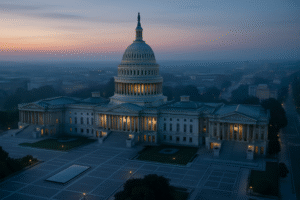Duration & Credit Pulse
Executive Summary
Bottom Line: Markets displayed remarkable equilibrium during Trump's inauguration week, with Treasury yields edging marginally lower while credit spreads compressed to extreme tights. The VIX's decline to the 18th percentile signals complacency despite the administration's sweeping Day One executive orders, suggesting investors are betting on pro-business policies outweighing potential trade and immigration disruptions.
Duration Dashboard
| Maturity | January 17, 2025 | January 24, 2025 | Weekly Δ | 5-Year Percentile |
|---|---|---|---|---|
| 2‑Year | 4.29% | 4.27% | -2 bp | 69th %ile (elevated) |
| 5‑Year | 4.43% | 4.43% | -1 bp | 92nd %ile (extreme) |
| 10‑Year | 4.63% | 4.62% | -1 bp | 97th %ile (extreme) |
| 30‑Year | 4.86% | 4.85% | -1 bp | 97th %ile (extreme) |
Treasury Yield Curve Stability
Curve Analysis: The Treasury curve exhibited remarkable stability during a week of profound political transition. The minimal 1-2bp declines across all maturities suggest markets had already priced in Trump's policy agenda, with investors adopting a wait-and-see approach rather than reacting to Day One executive orders.
Treasury markets demonstrated unusual calm during Trump's inauguration week, with yields declining just 1-2 basis points across the curve despite the administration signing 26 executive orders on Day One. This stability, even as yields remain at extreme percentiles (92nd-97th), suggests markets had already positioned for the new administration's policies. The muted reaction may reflect confidence that Trump's pro-business agenda will offset potential disruptions from immigration and trade policies.
Credit Pulse
| Metric | January 17, 2025 | January 24, 2025 | Weekly Δ | 5-Year Percentile |
|---|---|---|---|---|
| IG OAS | 0.74 bp | 0.74 bp | 0 bp | 16th %ile (tight) |
| HY OAS | 2.66 bp | 2.61 bp | -5 bp | 9th %ile (extreme tight) |
| VIX Index | 15.97 | 14.85 | -1.12 | 18th %ile (low) |
Credit markets embraced risk during inauguration week, with high-yield spreads compressing to an extreme 9th percentile—the tightest levels in five years. This compression, coupled with the VIX falling to the 18th percentile, reveals profound market optimism about Trump's business-friendly agenda. Investment-grade spreads holding steady at tight levels further confirms credit investors' confidence that deregulation and potential tax cuts will boost corporate profitability despite trade policy uncertainties.
US Macroeconomic Assessment – The Trump Era Begins
President Trump's return to the White House on January 20 marked the beginning of an ambitious policy agenda that could reshape the American economy. His Day One executive orders spanned immigration, energy, federal workforce restructuring, and trade policy signals—creating both opportunities and risks for financial markets. The immediate market reaction was surprisingly positive, with equities rallying despite the sweeping changes announced.
Executive action blitz: Trump signed 26 executive orders on his first day, the most of any president in history. Key economic measures included declaring a national emergency at the southern border, initiating federal workforce reductions, pulling out of the Paris Climate Agreement, and signaling future tariff actions. Notably absent were immediate tariff implementations, which may have contributed to market relief. The administration's stated intent to impose 25% tariffs on Mexico and Canada by February 1 keeps trade uncertainty elevated.
Market dichotomy: The calm in Treasury markets contrasts sharply with the policy upheaval, suggesting investors had already positioned for Trump's return. The equity rally on Tuesday's first trading day—with the Dow gaining 2.5% for the week—indicates markets are prioritizing expected tax cuts and deregulation over near-term disruption risks. This optimism may prove premature if immigration enforcement and trade conflicts materialize as advertised.
Federal Reserve Policy Outlook
The Federal Reserve finds itself in an increasingly complex position as Trump's policy agenda unfolds. Markets have fully priced in a pause at the January 28-29 FOMC meeting, with fed funds futures showing virtually no chance of any policy action. The combination of still-elevated inflation, economic resilience, and uncertainty about the new administration's fiscal and trade policies creates a compelling case for the Fed to maintain its wait-and-see approach.
Chair Powell faces the delicate challenge of maintaining Fed independence while navigating an administration that has historically been vocal about monetary policy preferences. The central bank must assess whether Trump's policies will prove inflationary (through tariffs and fiscal expansion) or disinflationary (through increased productivity and labor supply changes). Markets have scaled back 2025 rate cut expectations dramatically, now pricing just 50 basis points of easing compared to 100 basis points expected weeks ago.
Week Ahead: Fed Meeting and Policy Clarity
- FOMC meeting (Jan 28-29): The Fed is expected to hold rates steady and likely maintain a cautious tone about future policy moves. Powell's press conference will be scrutinized for any hints about how the Fed views Trump's policy agenda.
- Trump's first full week: Markets will watch for additional executive orders and clarification on trade policy timelines, particularly regarding the threatened February 1 tariffs on Canada and Mexico.
- Q4 GDP (Jan 30): Fourth quarter growth data will provide a baseline for assessing the economy's momentum entering the Trump era. Consensus expects solid 2.7% annualized growth.
- Corporate earnings season: Major tech earnings will test market optimism, with particular focus on companies exposed to global supply chains and potential trade disruptions.
US Economic Positioning and Global Context
Trump's inauguration week highlighted the unique position of the US economy—strong enough to weather policy uncertainty yet vulnerable to self-inflicted disruptions. The administration inherits an economy with 4% unemployment, moderating inflation, and solid growth momentum. This strength provides cushion for policy experiments but also reduces the economic case for dramatic interventions.
Policy collision course: The tension between Trump's various policy goals is becoming apparent. Aggressive immigration enforcement could tighten labor markets and fuel wage inflation, complicating the Fed's job. Trade restrictions could boost inflation while hurting growth. Yet tax cuts and deregulation could provide offsetting stimulus. Markets are betting the pro-growth policies dominate, but execution risks loom large as the administration's ambitious agenda meets economic and political realities.
Key Articles of the Week
-
Trump signs executive actions on Jan. 6, TikTok, immigration and moreNPRJanuary 21, 2025Read Article
-
Stocks rally to close out strong week, await Trump policiesReutersJanuary 18, 2025Read Article
-
A round-up of global stock markets in Trump's inauguration weekEuronewsJanuary 24, 2025Read Article
-
Trump's first week: what does it mean for your money?MoneyWeekJanuary 24, 2025Read Article
-
Initial Rescissions Of Harmful Executive Orders And ActionsThe White HouseJanuary 21, 2025Read Article
-
US Stock Market Outlook 2025: Policy Changes and VolatilityIGJanuary 14, 2025Read Article
-
Trump executive orders 2025: What he's signed, other expected actsNBC WashingtonJanuary 21, 2025Read Article
-
US stock performance on dates of presidential inaugurationsReutersJanuary 20, 2025Read Article






